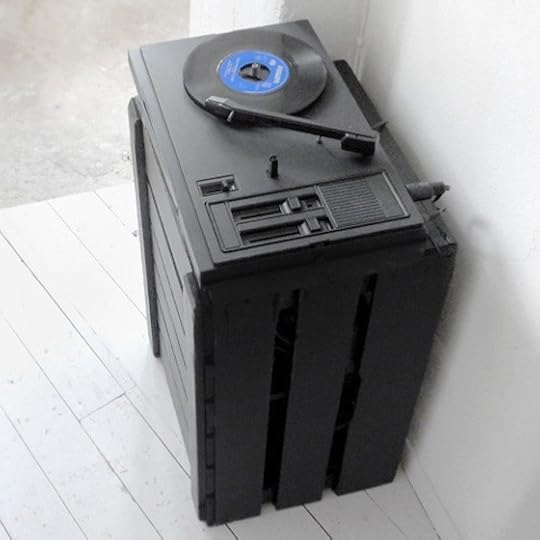Marc Weidenbaum's Blog, page 447
August 29, 2013
Disquiet Junto Project 0087: Entry Music

Each Thursday at the Disquiet Junto group on Soundcloud.com a new compositional challenge is set before the group’s members, who then have just over four days to upload a track in response to the assignment. Membership in the Junto is open: just join and participate.
This assignment was made in the evening, California time, on Thursday, August 29, with 11:59pm on the following Monday, September 2, 2013, as the deadline.
These are the instructions that went out to the group’s email list (at tinyletter.com/disquiet-junto):
Disquiet Junto Project 0087: Entry Music
This week’s project focuses on functional music. You will compose and record five different doorbell sounds, or sounds that might serve as the equivalent of a doorbell.
The concept is that the home’s resident has the option to alter the doorbell at the click of a button, and can choose between five doorbell options: (1) Daytime, (2) Evening, (3) Slumber, (4) Delicate, (5) Party. The resident also has the option to turn off the doorbell entirely, so none of your settings should be silent.
You will compose and record a suite of five sounds, one for each of those settings. You will then create a single track consisting of each ring/bell/tone playing for roughly five seconds. Your finished track should be approximately 25 seconds long.
Additional Background: The (1) Daytime tone is the default sound you intend for the doorbell. The (2) Evening tone is the one that would play from roughly dinner time on until bedtime. The (3) Slumber tone is one that would ring out while you are sleeping. The (4) Delicate tone is one that would play for someone who, say, has a baby at home, or who is ill, or is in a period of mourning or grief. And the (5) Party mode is a tone that would be heard even if a raucous party were going on.
Deadline: Monday, September 2, 2013, at 11:59pm wherever you are.
Length: Your track should have a duration of approximately 25 seconds.
Information: Please when posting your track on SoundCloud, include a description of your process in planning, composing, and recording it. This description is an essential element of the communicative process inherent in the Disquiet Junto.
Title/Tag: Include the term “disquiet0087-entrymusic” in the title of your track, and as a tag for your track.
Download: Please consider employing a license that allows for attributed, commerce-free remixing (i.e., a Creative Commons license permitting non-commercial sharing with attribution).
Linking: When posting the track, be sure to include this information:
More on this 87th Disquiet Junto project, which consists of five varied doorbell rings, at:
http://disquiet.com/2013/08/29/disqui...
More details on the Disquiet Junto at:
http://soundcloud.com/groups/disquiet...
August 26, 2013
“How Love,” How Hip-Hop? (MP3)
The extent to which the uploaded standalone singles by SoundCloud regular Patrick Ellis count as instrumental hip-hop might be gauged according to their content. Much of his work has a delectable downtempo quality. Some is downright ambient thanks to an emphasis on tonal material and surface noise. Others, like the recently posted “How Love / Blue Sky Sprites,” venture more solidly into hip-hop swagger. The track has Ellis’ trademark interest in minimal impact, select source audio, and a hazy, afternoon vibe. Here it is produced with such elements as two soulful vocal samples (one a sped-up melisma), sentimental chimes, and a rhythm just far enough off the beat to arguably register as funky. And at just 1:12, “How Love / Blue Sky Sprites” is suitable for setting on repeat.
Track originally posted for free download at soundcloud.com/patrick.
August 24, 2013
Hush, Tone, Whine (MP3)
With no more than a title (“Color Block”) and a tag (“experimental electronic”), Gaapiiiii‘s recently posted track is a highly recommended eight-minute sound excursion. The main components are a wash of white noise and a synthetically tinged choral hush, along with the peaked-out whine of a sine tone that overlaps with each, as they alternate back and forth. The result is a kind of story-less narrative, these compelling but distinctly complementary aspects (one beyond tone, one richly harmonic) suggesting contrasting viewpoints.
Track originally posted for free download at soundcloud.com/gaapiiiii. Gaapiiiii, who only otherwise identifies himself as G P on SoundCloud, is based in Japan.
August 23, 2013
Up Your Alley (MP3)

Each of the silhouettes in the above image portrays a different narrow, alley-like place in Amsterdam. The term for such places in Dutch is “tussen-ruimte,” which means a “between-space.”
The term also serves as the title for a month-long series of events and exhibits, including walking tours and installations and films, in Amsterdam, put together by the Castrum Peregrini cultural organization. The Tussen-ruimte program runs from yesterday, August 22, through September 22. Among the films, naturally, will be work by the late Gordon Matta-Clark, whose split houses set a precedent for this sort of investigative operation, as did, more specifically, his purchase in the early 1970s of dozens of tiny plots of land around Manhattan. The latter project he called “Reality Properties: Fake Estates.” Here is an image of his sketches of some of those plots:

Also participating in Tussen-ruimte is Rutger Zuydervelt, the musician and sound artist better known as Machinefabriek. His “Grachtengroeven” installation explores the between spaces of vinyl records, better known as grooves. Here is a recording of one of his locked grooves. The repetition has the sense of someone pacing in circles, as if trapped in a confined area, and resulting audio presents a claustrophobic sound design, all pneumatic thudding and electrical whir. It could easily be a minimal techno single from the Chain Reaction record label, circa 1995.
A brief description accompanying the Machinefabriek track explains a bit more about “Grachtengroeven”:
The empty grooves of a vinyl record form the space between the previous and the next song. Like the alleys between the Amsterdam canal houses they might seem empty and useless, but on closer inspection they are worlds in themselves. ‘Grachtengroeven’ (Canal grooves) positions the needle of a pick-up in a between space of a record and makes the void audible in a rhythmic soundtrack for the ‘Tussen-ruimte’ exhibition.
And this is a shot of it as it appears in the gallery space:

Track originally posted for free download at soundcloud.com/machinefabriek. More from Machinefabriek at machinefabriek.nu. More on the exhibits and events at tussen-ruimte.com. More on the sponsoring organization at castrumperegrini.org. Gordon Matta-Clark drawing via queensmuseum.org.
August 22, 2013
Disquiet Junto Project 0086: Hyperloop

Each Thursday at the Disquiet Junto group on Soundcloud.com a new compositional challenge is set before the group’s members, who then have just over four days to upload a track in response to the assignment. Membership in the Junto is open: just join and participate.
This assignment was made in the evening, California time, on Thursday, August 22, with 11:59pm on the following Monday, August 26, 2013, as the deadline.
These are the instructions that went out to the group’s email list (at tinyletter.com/disquiet-junto):
Disquiet Junto Project 0086: Hyperloop
This week’s project may have the simplest, and broadest, instruction in all of the 86 consecutive weeks that the Disquiet Junto has been running. Thanks to the musician Cinchel of Chicago, Illinois, for helping to prompt this idea. The project has just one instruction:
The title of your next single is “Hyperloop.” Now, record that single
Deadline: Monday, August 26, 2013, at 11:59pm wherever you are.
Length: Your track should have a duration of between 1 and 5 minutes.
Information: Please when posting your track on SoundCloud, include a description of your process in planning, composing, and recording it. This description is an essential element of the communicative process inherent in the Disquiet Junto.
Title/Tag: Include the term “disquiet0086-hyperloop” in the title of your track, and as a tag for your track.
Download: Please consider employing a license that allows for attributed, commerce-free remixing (i.e., a Creative Commons license permitting non-commercial sharing with attribution).
Linking: When posting the track, be sure to include this information:
More on this 86th Disquiet Junto project, in which a song was made based on its assigned title (“Hyperloop”), at:
http://disquiet.com/2013/08/22/disqui...
More on the Tesla Hyperloop at:
http://www.teslamotors.com/blog/hyper...
More details on the Disquiet Junto at:
http://soundcloud.com/groups/disquiet...
Above image via telegraph.co.uk.
August 21, 2013
The 3D Melody (MP3)
Another short piece, under a minute, following yesterday’s bit of flute-based looping. Today it is a plucky, downtempo melody on what has the playful insouciance of a toy piano. Best listened to on headphones, which allow for the use of stereophonic spatialization to become apparent. A lot of times the phrase “headphone music” suggests something spacey and proggy, but here each note moves back and forth, its placement as much a part of the melodic development as its relative pitch. The track is credited to Brooklyn-based Sharp Hands:
Track originally posted for free download at soundcloud.com/sharphands.
August 20, 2013
Flute Loops (MP3)
Like yesterday’s track, today’s is a sketch, and it involves looping, and the source instrument is one from a pre-electronic era. Yesterday that instrument was a guitar. Today it’s a flute. The track is a one-minute experiment by Margaret “Margot” Collins, who posts as Margonaut at SoundCloud.com. The piece layers a variety of flute material — lush sound beds, pizzicato piping, melodic and rhythmic fragments — into a gently pulsing lull. What pulls it all together is that the ever intensifying incremental developments build both a sense of density and a sense of stasis — it’s as if as the track increases one sort of momentum, it actively loses another.
Track originally posted for free download at soundcloud.com/margonaut. More from Collins at alwaysadapting.com
August 19, 2013
Guitar Loop (MP3)
The artist known as Toaster has uploaded a lovely swath of guitar-looping ambience whose title, “Unreasonable Sketch,” suggests the presence of a tension that the track pleasantly refuses to oblige. The foundation of it is a deep, undulating lull of hazy layering. What makes it a sketch is hinted at as it proceeds, as the sinuous audio gives way to a melodic strain — not the light strumming that came early on, but a more pointed, singular sound, less like a guitar, and more like a single finger on an old keyboard synthesizer making a hesitant push toward a proper lead line. It comes on so slowly, so absent of eagerness, that the ear might not even notice it until the element is fairly far along. The track inevitably fades out, which is the nature of instrumental sketches. It will be interesting to hear where Toaster takes this.
Track originally posted for free download at soundcloud.com/toaster-1. More from Toaster, aka Todd Elliott of San Jose, California, at twitter.com/toddbert and toaster.bandcamp.com.
August 15, 2013
Disquiet Junto Project 0085: 3 Parts

Each Thursday at the Disquiet Junto group on Soundcloud.com a new compositional challenge is set before the group’s members, who then have just over four days to upload a track in response to the assignment. Membership in the Junto is open: just join and participate.
This assignment was made in the evening, California time, on Thursday, August 15, with 11:59pm on the following Monday, August 19, 2013, as the deadline.
These are the instructions that went out to the group’s email list (at tinyletter.com/disquiet-junto):
Disquiet Junto Project 0085: 3 Parts
This week’s project is fairly open-ended. It involves making a simple song, and just three directions are involved.
The goal is to make a song with three parts: (1) beat, (2) background sound bed, and (3) melody.
You will make the beat with an oscillator.
You will make the background sound bed with a drum machine.
You will make the melody with a field recording.
Note: Software versions or equivalents of the oscillator and the drum machine are certainly allowed, and you can process any of the material, so long as the final heard audio bears a recognizable resemblance to the source audio.
Deadline: Monday, August 19, 2013, at 11:59pm wherever you are.
Length: Your track should have a duration of between 1 and 3 minutes.
Information: Please when posting your track on SoundCloud, include a description of your process in planning, composing, and recording it. This description is an essential element of the communicative process inherent in the Disquiet Junto.
Title/Tag: Include the term “disquiet0085-3parts” in the title of your track, and as a tag for your track.
Download: Please consider employing a license that allows for attributed, commerce-free remixing (i.e., a Creative Commons license permitting non-commercial sharing with attribution).
Linking: When posting the track, be sure to include this information:
More on this 85th Disquiet Junto project, in which a song is made with three simple parts (oscillator, drum machine, field recording), at:
http://disquiet.com/2013/08/15/disqui...
More details on the Disquiet Junto at:
http://soundcloud.com/groups/disquiet...
Image found via wikimedia.org.
August 8, 2013
Disquiet Junto Project 0084: Quotidian Thread

Each Thursday at the Disquiet Junto group on Soundcloud.com a new compositional challenge is set before the group’s members, who then have just over four days to upload a track in response to the assignment. Membership in the Junto is open: just join and participate.
This assignment was made in the evening, California time, on Thursday, August 8, with 11:59pm on the following Monday, August 12, 2013, as the deadline.
These are the instructions that went out to the group’s email list (at tinyletter.com/disquiet-junto):
Disquiet Junto Project 0084: Quotidian Thread
This week’s project involves field recordings. It entails the process of connecting two brief recordings of everyday sound. The connection is made by locating an element within each of the two recordings, and then creating a transition from one to the next. The finished track should be a maximum of 60 seconds long. As always, it is greatly appreciated if you can describe your decision-making in the text that accompanies your uploaded track.
The steps are as follows:
Step 1: Record two brief field recordings. One should be fairly noisy and the other relatively quiet.
Step 2: Listen closely to both recordings and locate a useful 10-second segment in each. Trim the two 10-second segments.
Step 3: Listen closely to the fairly noisy 10-second segment, and in it locate a single sound that is prominent enough to be isolated.
Step 4: Listen closely to the relatively quiet 10-second segment, and in it locate a single sound that is prominent enough to be isolated.
Step 5: Develop an original composition that is structured as follows: The first 10 seconds are of the noisy field recording. During the final second, the noisy field recording should slowly fade out. As it fades, the one sound you have elected to isolate in Step 3 should continue playing. After the rest of the recording has faded away entirely, that one isolated sound from Step 3 should slowly transform into the sound that you elected to isolate in step 4. Once the transition from the Step 3 isolate to the Step 4 isolate is complete, you should fade in the 10-segment of the relatively quiet field recording.
Step 6: You are now done.
Deadline: Monday, August 11, 2013, at 11:59pm wherever you are.
Length: Your track should have a duration of between 30 and 60 seconds.
Information: Please when posting your track on SoundCloud, include a description of your process in planning, composing, and recording it. This description is an essential element of the communicative process inherent in the Disquiet Junto.
Title/Tag: Include the term “disquiet0084-quotidianthread” in the title of your track, and as a tag for your track.
Download: Please consider employing a license that allows for attributed, commerce-free remixing (i.e., a Creative Commons license permitting non-commercial sharing with attribution).
Linking: When posting the track, be sure to include this information:
More on this 84th Disquiet Junto project, in which two distinct field recordings are connected through a transition between isolated elements, at:
http://disquiet.com/2013/08/08/disqui...
More details on the Disquiet Junto at:
http://soundcloud.com/groups/disquiet...



